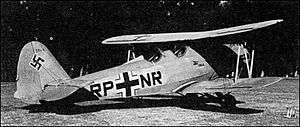Gotha Go 145
| Go 145 | |
|---|---|
 | |
| Role | Trainer |
| Manufacturer | Gotha |
| Designer | Albert Kalkert |
| First flight | February, 1934 |
| Introduction | 1935 |
| Retired | 1945[1] |
| Primary user | Luftwaffe |
| Number built | 1,182 (German production) |
The Gotha Go 145 was a German World War II-era biplane of wood and fabric construction used by Luftwaffe training units. Although obsolete by the start of World War II, the Go 145 remained in operational service until the end of the War in Europe as a night harassment bomber.
Development
On 2 October 1933 the Gotha aircraft company was re-established. The first aircraft manufactured was the Gotha Go 145,[2] a two-seat biplane designed by Albert Kalkert made out of wood with a fabric covering. The Go 145 featured fixed landing gear and was powered by an Argus As 10C inverted V8 air-cooled engine fitted with a two-blade fixed-pitch propeller. The first prototype took to the air in February 1934, and was followed by a production model, the Gotha Go 145A, with controls in both cockpits for trainee and instructor.
Operational history
In 1935, the Go 145 started service with Luftwaffe training units. The aircraft proved a successful design and production of the Go 145 was taken up by other companies, including AGO, Focke-Wulf and BFW. Licensed versions were also manufactured in Spain and Turkey. The Spanish version, called the CASA 1145-L actually remained in service until long after World War II.[2]
Ignoring prototypes, 1,182 Go 145s were built in Germany for Luftwaffe service. An unknown number of license-produced Go 145s were also built. Further development of the aircraft was done. The Gotha Go 145B was fitted with an enclosed cockpit and wheel spats (an aerodynamic wheel housing on fixed-gear). The Go 145C was developed for gunnery training and was fitted with a single 7.92 mm (.312 in) MG 15 machine gun in the rear cockpit, requiring removal of that cockpit's flight controls.
By 1942, the Russians began using obsolete aircraft such as the Polikarpov Po-2 to conduct night harassment missions against the Germans. Noting the success of the raids, the Germans began conducting their own night harassment missions with obsolete aircraft on the Eastern Front. In December 1942, the first Störkampfstaffel (harassment squadron) was established and equipped with Gotha Go 145 and Arado Ar 66. The night harassment units were successful and by October 1943 there were six night harassment squadrons equipped with Gotha Go 145.
Also in October 1943, the Störkampfstaffeln were brought together into larger Nachtschlachtgruppe (NSGr) (night ground attack group, literally night battle group) units of either three or four squadrons each. In March 1945 Nachtschlachtgruppe 5 had 69 Gotha Go 145’s on strength of which 52 were serviceable [3] while Nachtschlachtgruppe 3 in the Courland Pocket had 18 Gotha Go 145’s on strength of which 16 were serviceable.[4] When the war in Europe ended on 8 May 1945 the Gotha Go 145 equipped the majority of the Nachtschlachtgruppen.
Operators
-
 Austria
Austria - Austrian Air Force – 12 aircraft delivered in 1937[5]
-
 Czechoslovakia
Czechoslovakia - Czechoslovakian Air Force (Postwar)
-
.svg.png) Germany
Germany - Luftwaffe
-
 Romania
Romania - Royal Romanian Air Force
-
 Slovakia
Slovakia - Slovak Air Force (1939–45)
-
 Spain
Spain - Spanish Air Force
-
 Turkey
Turkey - Turkish Air Force
Surviving aircraft
- Gotha Go 145A – Museum für Verkehr und Technik. Berlin, Germany.
- Gotha Go 145A – Norsk Luftfartssenter. Bodø, Norway.
Both examples are badly damaged and are in storage.
Specifications (Go 145A)
Data from Kay & Smith, p. 116.
General characteristics
- Crew: 2 (pilot, instructor)
- Length: 8.7 m (28 ft 6½ in)
- Wingspan: 9 m (29 ft 6⅓ in)
- Height: 2.9 m (9 ft 6 in)
- Wing area: 21.75 m² (234.10 ft²)
- Empty weight: 800 kg (1,940 lb)
- Loaded weight: 1,380 kg (3,043 lb)
- Powerplant: 1 × Argus As 10 inline, 179 kw (240 hp)
Performance
- Maximum speed: 212 km/h (132 mph)
- Range: 630 km (391 mi)
- Service ceiling: 3,700 m (12,139 ft)
See also
- Aircraft of comparable role, configuration and era
References
| Wikimedia Commons has media related to Gotha aircraft. |
Notes
Bibliography
- Bishop, C. Luftwaffe Squadrons, 1939–1945. Amber Books, 2006.
- Donald, D. (ed.) Warplanes of the Luftwaffe: Combat aircraft of Hitler’s Luftwaffe, 1933–1945. Aerospace Publishing, 2001.
- Green, William. Warplanes of the Third Reich. London: Macdonald and Jane's Publishers Ltd., 1970 (fourth impression 1979). ISBN 0-356-02382-6.
- Nowarra, Heinz J. Die Deutsche Luftrüstung 1933–1945 (in German). Koblenz, Germany: Bernard & Graeffe Verlag, 1993. ISBN 3-7637-5464-4.
- Smith, J. Richard and Kay, Anthony L. German Aircraft of the Second World War. Annapolis, MD: US Naval Institute Press, 2002. ISBN 1-55750-010-X.
- Wood, Tony and Gunston, Bill. Hitler's Luftwaffe: A pictorial history and technical encyclopedia of Hitler's air power in World War II. London: Salamander Books Ltd., 1977. ISBN 0-86101-005-1.